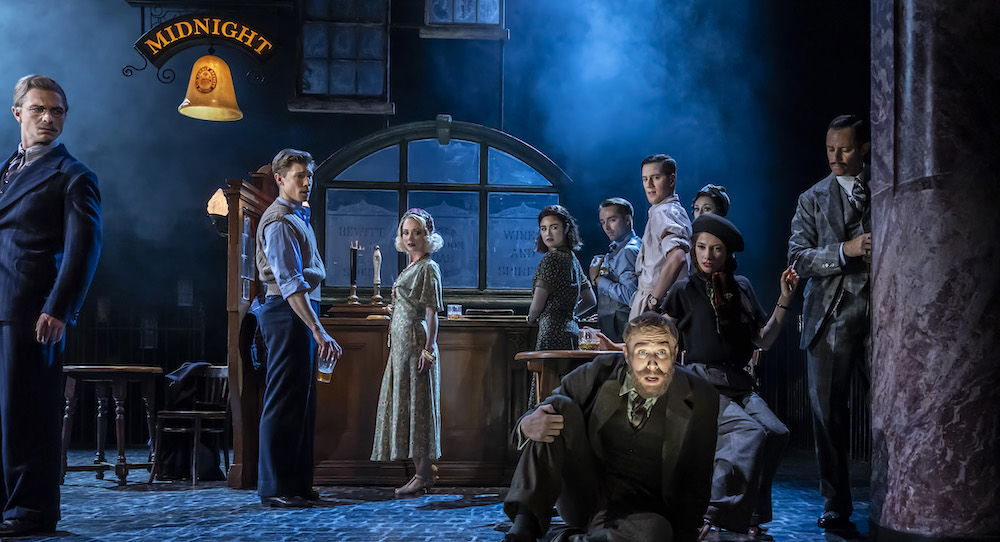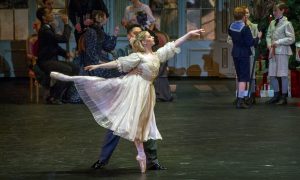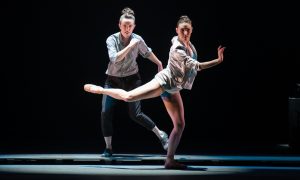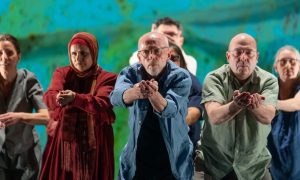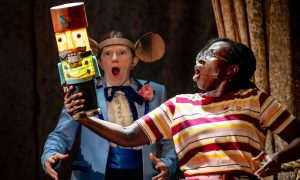Theatre Royal Brighton, England.
30 July 2025.
Matthew Bourne’s New Adventures’ production of The Midnight Bell is like an intense form of people-watching.
It is one of the most compelling pieces of theatre I’ve seen.
The opening shines a dusty spotlight on an optimistic young man, miming to a 1930s song and dancing joyfully, grabbing the pillow from the bed as a partner. It’s fun and engaging. Then his alarm clock blasts – we’d been watching his dream of happiness. He sighs and makes his way to work as a waiter at the Midnight Bell.
With the brief prior knowledge that the stories of the Midnight Bell characters would not be explicit, I was curious to know how this would be managed — how we would understand the story, its message and culmination.
It transpired that it was not one story, but 10 stories of 10 lonely individuals drawing us in to their worlds; the common ground being the pub – The Midnight Bell – where they drank. We actually delved deeper in to their souls than would ever have been possible through any other language than dance. The 10 individuals which included a barmaid, a waiter, a spinster and a prostitute, interacted apprehensively initially and gradually coupled up. Some even changed partners a couple of times, including an intoxicating scene when seductive music, dancing and drinking brought them all closer. There was jealousy and indignation, and at one point all changed to dance with same sex partners.
The stage was dark, smoky and shadowy. The bar of the Midnight Bell moved positions, enabling us fresh viewpoints. Windows and signs of establishments – tearooms, cinema and the motel – hung at various depths on the stage, creating a believable 1930s London street scene, complete with silhouetted buildings on the backdrop, the sky at various stages of night or early morning. The windows were flown in from the wings, which were open – backstage staff were visible and dressed in grey suits in keeping with the time period.
The drinking itself played a huge part in the production. The glasses of whisky were used rhythmically, choreographically, and sometimes simultaneously. For example, they all banged their glasses down together at one point, which offered a fabulous effective link across all their narratives. The way they took a gulp, or a sip, their eye line and body language offered so much insight. The way they conversed with the waiter or stole a glance at another across the room. Like in a choose-your-own-adventure book or game, the audience were free to create their own narratives for their actions.
This cast of gorgeously expressive dancers delivered such powerfully executed duets, with lifts, a lot of ballroom style dance and even stage fighting as they stayed true to their personas. Some of the dancing wasn’t actual dancing but very cleverly precise choreographed movement, so stylistic and characterised it could only have been conveyed by dancers.
In Act 2, the park bench became a story vessel, used in different ways by the characters. A time for relationships to blossom and deepen. A lot of sexual tension fizzed between the various couples here. We were subject to many fly-on-the-wall moments that screamed the obvious – he was ashamed of his true feelings, she felt obliged to say yes to going out with him because she was lonely, he yearned for her on a deeper level than her usual way of offering, and she took whatever breadcrumbs he was offering because she was lonely.
But none of them seemed able to read the other deeply. Maybe a reminder that we are often unable to see the bigger picture when we are centrally involved?
Betrayal, physical violence and repentance, unrequited love, lust over love, and denial swam through the choreography. I wondered which the audience was identifying the most with. Not forgetting humour, which was laced lightly in moments such as the puppy dog eyes of the waiter when the prostitute walked into the bar.
I wasn’t convinced that the miming to 1930s songs at intervals throughout added positively to the narrative journey, though the care over the lyric choices were clear, and it did take a breath from the intense score.
‘What is this thing called love’ was echoed from their mimed lips as they moved, as always, through their own lives. That was powerful, as it spoke of the varying ways that ‘love’ was manifesting its way through their experiences.
Our eyes darted to every corner of the stage where some part of someone’s story was developing. If watched again, like a movie or novel, little missed nuances would certainly reveal themselves. The score was intricate and ingeniously put together as it illustrated the five different couples perfectly, at the same time. It was varied – sometimes lyrical piano, sometimes yearning strings, with a marimba underneath building suspense.
The bed was central towards the end; scenes of intimate seduction of very different natures unfolded. The bed itself shared, not in a literal sense, but as a prop by different couples who happen to be on stage at the same time.
The spinster ties the cad to the bedpost with his own tie and leaves. A piercing high note reverberates in our ears as the man with schizophrenia strangles his lover. She falls back limp onto the bed. A bleak Christmas is then celebrated in the pub. Paper hats, and drab expressions, the sense of betrayal lurking, and sorrow sparking the atmosphere.
These lonely souls all ended up back in the pub. Still drinking. And still deeply unhappy.
The two men held hands under the table. Their relationship still hidden? The barmaid, extracted from the relationship she never wanted, but then rejected from the one she did want. The man suffering with schizophrenia who strangled his lover, sees her alive and well in the last scene. Exquisitely done. Is she really there, or is she an hallucination?
They’re all still alone and unhappy, though possibly now in different ways.
“There’s a man and his dreams.”
And blackout.
And I have a thousand thoughts and questions. Exceptional.
By Louise Ryrie of Dance Informa.


